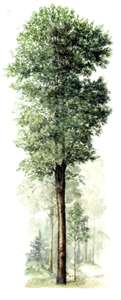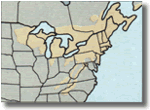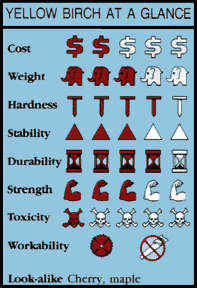The shimmering queen of the north


There’s no sight in the woods that quite compares to a stand of yellow birch. The bronze-barked trees glisten against their neighbors. Light bounces off them, as if reflected from metal.
The beauty of yellow birch on the stump probably captivated colonial New England craftsmen, too. But, it was the tree’s strong, golden wood that they treasured. From it, they expertly crafted Windsor-style chairs, tables, and other furniture to withstand decades of use and abuse. Centuries later—at the peak of this wood’s popularity in the 1950s—homes across the nation featured sturdy, blonde cabinets of yellow birch.
Wood identification

Yellow birch (Betula alleghaniensis), also called silver birch and swamp birch, is one of 50 species of birch found around the world. Situated in a wide range across the northern U.S. and Canada, yellow birch grows best in rich, moist woodlands by rivers and streams.
Easily recognized by its metallic-looking bark with numerous papery curls and strips, the forest-grown yellow birch attains 60-70′ heights and 3′ diameters.
Before leaves appear in the spring, twigs bear brown buds and branch ends boast two or three catkins containing pollen. By summer, the buds develop into toothed and pointed leaves measuring about 3-4″ long. Along the branches, small cones with seeds inside appear, only to drop off in the fall.
What little sapwood you find in yellow birch will be nearly white, while heartwood has an array of color. The wood varies from cream to golden tan to light walnut. Some wood may even have gray and red tinges.
Although birch has a distinct grain pattern—sometimes displaying waves or curls—the fine-textured wood doesn’t always overpower the eye. And, at 43 pounds per cubic foot dry, it weighs almost the same as sugar maple, although it’s not as hard.
Uses in woodworking
Along with maple, yellow birch has always been a standard for items that get lots of use—chairs, tables, desks, and cabinets. And, it often turns up as doors and moldings as well as floors.
Many of the turned products sold in homecenters are yellow birch. It’s also used for dowels, dowel pins, screw-hole buttons and plugs, and shaker pegs.
AvailabiIity

Yellow birch lumber usually sells should be readily available. Stock from the northern part of its range is harder, has fewer defects, and stains better.
Although you normally won’t find lumber with much sapwood, manufacturers of rotary cut yellow birch veneer make the distinction. It’s offered as “natural,” including heartwood and sapwood, and “select white,” from sapwood.
Machining methods
Yellow birch machines a little easier than maple, a wood with similar characteristics. That’s because yellow birch normally has a finer, more even grain than maple. However, it does have a moderate dulling effect on cutting edges that requires carbide tips. When yellow birch does misbehave, here’s what to do:
- The wood planes smoothly 90 percent of the time. However, spinning cutters, as on a planer, sometimes catch wavy grain and tear out a pockmark. When this occurs, try reversing the board and taking a shallower cut.
- Yellow birch normally joints cleanly, but trying to decide grain direction to determine feed sometimes can be impossible. When in doubt as to feed direction, set table height for cuts of 1/16″ to 1/8″ and decide by trial and error.
- Nearly as dense as maple, yellow birch requires ripping with a rip-profile blade of 24 teeth or fewer to avoid clogging. A steady feed rate reduces burning.
- In crosscutting, steel fine-toothed plywood blades work well to avoid splintering. Today’s thinly veneered birch plywood splinters easily, too. Score the line to be cut or place masking tape on the kerf line and saw right through it.
- Back drill bits out frequently to clear the hole and avoid burning, especially in end grain.
- Use router bits with ballbearing pilots to avoid burning, and, if possible, rout slowly. Cross-grain cuts require shallow passes.
- Beware of squeeze-out when gluing. Dry glue, when scraped off, can grab the wood and tear it away. To detect squeeze-out, wipe the wood with paint thinner. And, don’t let clamps contact squeeze-out—black stains result.
- Wipe yellow birch with a damp cloth to raise grain prior to staining or clear-finishing. Sand, then stain. When grain has a differing color or pattern, expect uneven staining, or first prepare the surface with a product such as Minwax Wood Conditioner.
Carving comments
- Yellow birch, although hard, does take fine detail and has its place in relief work. It requires special handling, however.
- Gouge bevels (15° to 20°) dull quickly. Keep a sharp edge with a 10° bevel on the back side.
- Wavy grain will be more difficult to carve because the wavy areas will be harder than the plain.
- Power carvers should not begin with coarse-cutting burrs—the wood splinters. Use medium-cut burrs, then follow with finer ones.
Turning tips
Yellow birch couldn’t be easier to turn with sharp tools, aside from these exceptions:
- Scraping can produce splinters.
- Sanding the wood on the lathe across grain produces scratches. Instead, wipe with a damp cloth, then stop the lathe and sand with the grain using fine paper.
SHOP-TESTED TECHNIQUES THAT ALWAYS WORK

Any exceptions, and special tips pertaining to this issue’s featured wood species, appear under headings elsewhere on this page.
- For stability in use, always work wood with a maximum moisture content of 8 percent.
- Feed straight-grained wood into planer knives at a 90° angle. To avoid tearing, feed wood with figured or twisted grain at a slight angle (about 15°), and take shallow cuts of about 1/32″.
- For clean cuts, rip with a rip-profile blade that has 24-32 teeth. For crosscutting, use a blade with about 40 teeth.
- Avoid drilling with twist drills. They tend to wander and cause breakout. Use a backing board under the workpiece.
- Drill pilot holes for screws.
- Rout with sharp, preferably carbide-tipped, bits and take shallow passes to avoid burning.
- Carving hardwoods generally means shallow gouge bevels—15° to 20°—and shallow cuts.

